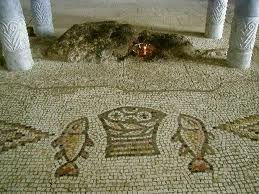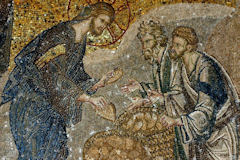In our previous post we explored Derrida's concepts of iterability and (un)translatability. In this post we apply the first of these concepts in an examination of iterations of the Eucharistic text.
As we begin, it is fitting to note that written liturgies of the Eucharist developed over an extended period. For example, we have allusions to the celebration of the Eucharist in the earliest house churches as attested by both biblical texts and Early Church writings which we will examine below. However, there was no Eucharistic prayer containing the Words of Institution as an original and integral part of the liturgy before the fourth century. Instead many scholars believe that Eucharistic prayers consisted of short benedictions having neither an Institution Narrative nor an Epiclesis.[1]
While written texts cannot be construed as synonymous with actual events (the iterative "texts" in which we are more interested), they provide the best evidence we have for what occurred within the communities that used these writings in liturgical settings. Within the received textual tradition, we are able to trace several changes that appear within various iterations of the telling of the first Last Supper.
 John Perry writes that the earliest Eucharistic meals were joyful celebrations observed on Sunday in memory of the discovery of the empty tomb. These celebrations were not yet tied to the Passion narrative, instead focusing on the eschatological hope of a quick inauguration of the Kingdom.[2] Traces of this earlier service are still found in all four gospels in the language used at the feeding of the multitudes, when Jesus takes the bread, blesses it, breaks it, and gives it to those gathered.[3]
John Perry writes that the earliest Eucharistic meals were joyful celebrations observed on Sunday in memory of the discovery of the empty tomb. These celebrations were not yet tied to the Passion narrative, instead focusing on the eschatological hope of a quick inauguration of the Kingdom.[2] Traces of this earlier service are still found in all four gospels in the language used at the feeding of the multitudes, when Jesus takes the bread, blesses it, breaks it, and gives it to those gathered.[3]
However, early in the tradition the remembrance of the Passover significance of Christ's sacrifice began to merge with the weekly liturgy of the meal. Perry suggests that this amalgamation of texts is the result of an attempt within the Pauline churches to more fully connect Gentiles converts with the example of Christ.[4] (Recall that drunkenness and overeating while others went without food were among the problems Paul addressed in his correspondence with the Corinthian church.) The biblical accounts of the Eucharist already exhibit this combination of liturgies within the first two generations of the early church. Let us take a moment to explore these iterations.
Deferring to the expert opinion of biblical scholars, we begin with Paul's first letter to the Corinthian church as the first extant reference to the meal. Here we find a claim of direct revelation from Jesus concerning how the ritual of the supper is to take place:
For I received from the Lord what I also delivered to you, that the Lord Jesus on the night when he was betrayed took bread, and when he had given thanks, he broke it, and said, "This is my body which is for you. Do this in remembrance of me." In the same way also he took the cup, after supper, saying, "This cup is the new covenant in my blood. Do this, as often as you drink it, in remembrance of me." For as often as you eat this bread and drink the cup, you proclaim the Lord's death until he comes. (1 Corinthians 11:23-26 TEV)
Though this is the majority reading, we also find a textual insertion in many manuscripts, adding the word "broken" to verse 24, producing instead: "This is my body which is broken for you."[5]
Returning chronologically to the next oldest reference in the Gospel of Mark, we find further elaboration on the ritual. Here, Jesus not only spoke of the bread and the cup, but we find explicit mention of distributing the symbolic elements to those gathered and an added description of the covenant in his blood as being poured out for many.[6]
Matthew builds on Mark's text, adding that it is the disciples who receive the bread, with a new command to eat, and that the blood of the covenant is for the remission of sins.[7]
Luke's narration includes not one cup but two: a new one at the beginning of the meal that Jesus tells the apostles to divide amongst themselves and the more familiar after-supper cup.[8]
It is interesting to note that the Acts account key to Marion's Eucharistic hermeneutic contains only two familiar elements: (1) Jesus himself is present and (2) he takes, blesses, and breaks the bread. There are no references to the Passion, and the cup is conspicuously absent from the meal. This iteration of the Eucharistic celebration would appear to be closer to the original form echoed in the feeding of the multitudes.
 The Johannine tradition does not contain a telling of the first supper, but a rocky history within the community can be reconstructed from traces found in the text. As previously mentioned the story of the feeding of the 5,000 appears in John 6:1-14. This story, with its lack of allusion to the Eucharistic cup appears to have been the earliest form of the shared meal, emphasizing the role of Christ as the new Moses who provides manna to the people and ushers in the Kingdom of God.
The Johannine tradition does not contain a telling of the first supper, but a rocky history within the community can be reconstructed from traces found in the text. As previously mentioned the story of the feeding of the 5,000 appears in John 6:1-14. This story, with its lack of allusion to the Eucharistic cup appears to have been the earliest form of the shared meal, emphasizing the role of Christ as the new Moses who provides manna to the people and ushers in the Kingdom of God.
Perry notes that in the synoptic tradition the Moses motif is further reinforced by Jesus' withdraw to commune with God alone (cf. Exodus 9:20; 34:28) and the subsequent sign in which he walks on water to rejoin his disciples, displaying his authority over the wind and water (cf. Exodus 14:21-29).[9] While this understanding is still reflected in John 6:35-51a, Perry suggests that the Johannine tradition joined the Passion memorial to the Eucharistic celebration in response to a different set of conditions – most likely the expulsion of the community from the synagogue – in an attempt to shore up morale by reminding the community of the trials suffered by Christ.
However, weekly references to eating flesh and drinking blood marred the joyful celebration for some who found this innovation difficult to accept or offensive (6:60-61), leading to the departure of a group of members from the community (6:66) which Perry believes accounts for Jesus' claim of having other sheep outside the Johannine fold (10:16).[10]
In addition to the biblical canon, the Didache is probably the next oldest extant text, generally considered to have been written somewhere between 70 and 100 CE. This early church document contains instructions for prayers before the distribution of the cup and the bread that contain no references to the Passion. Instead a new iteration is formulated in which the cup points to the holy vine of David made known through Jesus while the bread symbolizes the Church gathered together from the ends of the earth.[11]
Already a drift has occurred within the first two generations of Christian churches, from a Eucharistic celebration that joyfully calls participants to look forward to the eschatological return of Christ, to a merged liturgy that recalls the Passion of Christ and takes on the flavor of a sacrifice offered by the church. We review this trace to emphasize the development of a Eucharistic tradition over time, with successive iterations that introduce alterity in the understanding of meal.
In the setup for the Eucharistic hermeneutic, Marion is careful to point out that while the biblical text bears the scars of the previous irruption of the Word in the everyday affairs of the disciples, the Word is not in the text:
"Once things have happened, there remain only words: for us, there remains the text of the New Testament, just as for the disciples there remained only the rumor, or already the chronicle, of the putting to death… In both cases, the event referred to is lacking. We cannot lead the biblical text back as far as that at which it nevertheless aims, precisely because no hermeneutic could ever bring to light anything other than a meaning, whereas we desire the referent in its very advent."[12]
In light of Marion's assertion, one might ask why we have taken such pains to trace the development of the texts used in the Eucharistic celebration. I offer two reasons.
First, remembering that the texts of the New Testament reflect the Eucharistic practice of the communities that created them, we see that from the very beginning, iterability produced a variety of Eucharistic performances, included within our own canon, each of which would appear to have been sufficient to point past themselves to the foreclosed event of the death and resurrection of Christ.
But secondly, from a postmodern perspective, the biblical and subsequent liturgical texts that characterize the Eucharistic celebration are only one element in the larger performance of the Eucharistic "text" within community. In other words, not only are the written texts relevant to our discussion, but so are the additional components that come together to signify the foreclosed event, including the role of the bishop in Marion's description.
Having explored these early biblical/liturgical texts, our next post will turn to an exploration of the bishop's role in the Eucharistic performance.
[1] Robert F. Taft, "Mass Without the Consecration? The Historic Agreement on the Eucharist Between the Catholic Church and the Assyrian Church of the East Promulgated 26 October 2001," in Liturgical Renewal as a Way to Christian Unity, ed. J. F. Puglisi and Horace T. Allen (Collegeville: Liturgical Press, 2005), 210.
[2] John M. Perry, "The Sacramental Tradition in the Fourth Gospel and the Synoptics," in Jesus in Johannine tradition, ed. Robert Tomson Fortna and Tom Thatcher (Louisville: Westminster John Knox Press, 2001), 156.
[3] The feeding of the 5,000 is told in all four canonical gospels: Mark 6:31-44; Matthew 14:13-21; Luke 9:10-17; and John 6:5-15. A second feeding of 4,000 is recorded in Mark 8:1-9 and Matthew 15:32-39.
[4] Perry, "The Sacramental Tradition in the Fourth Gospel and the Synoptics," 158.
[5] This minority reading, found in many Greek manuscripts, remains an influential one, written into many Eucharistic liturgies including The Divine Liturgy of St. Basil and The Divine Liturgy of St. John Chrysostom. However, one might note from a hermeneutical perspective that while this iteration draws a parallel with the breaking of the bread in the same verse, the declaration of a broken body contradicts the crucifixion narratives that allude to Psalm 34:20 in declaring that Jesus' bones remained unbroken at his death.
[6] Mark 14:22-25
[7] Matthew 26:26-28
[8] Luke 22:14-20
[9] Perry, "The Sacramental Tradition in the Fourth Gospel and the Synoptics," 157.
[10] Ibid., 158.
[11] Didache X-XI
[12] Marion, God Without Being: 147.




Cripes! How complicated Christianity can be made to become by Christian intellectuals! I suspect Jesus, if who he said he was, was more interested in the benefit to the masses rather than this 2% group of erudite interpretations! Whose side was He on?
Loosen up guys!
Regards
Margaret Burn